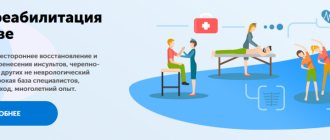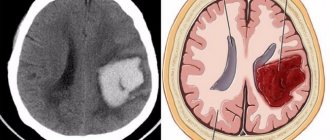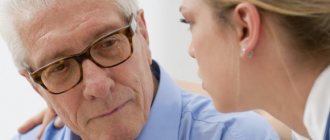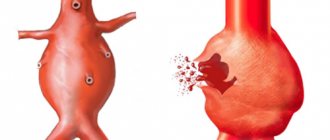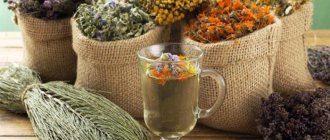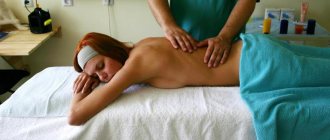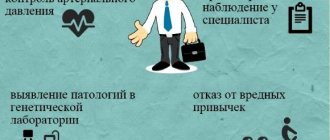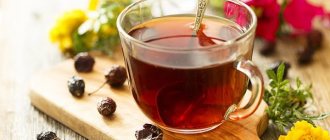Every year, more than 53% of deaths in Russia die due to a major stroke. This disease is characterized by pathology of blood circulation in the brain, as a result of which limbs are paralyzed, sensitivity disappears, and speech is impaired. If you contact a doctor in a timely manner, the attack can be localized, but the person’s internal organs are damaged.
Stroke survivors need long-term rehabilitation, help from family and friends, as well as a complete change in their usual lifestyle: proper nutrition, exercise, regular walks in the fresh air. It is possible to recover from a stroke if you know how to do it.
Stroke and its consequences
A stroke is a failure of blood circulation in the brain, a sharp narrowing of blood vessels that develops rapidly. Within a few minutes, partial or complete paralysis may occur (more often, the left side of the body is paralyzed).
Paralysis occurs due to oxygen starvation of the brain, which is a consequence of blockage or narrowing of blood vessels, as a result of which the functioning of the arms and legs deteriorates, the sensitivity of the body disappears, and speech is completely or partially impaired.
Today, stroke is considered one of the most common and dangerous pathologies. The disease develops against the background of chronic stress, fatigue, poor nutrition, lack of physical activity, bad habits and irregular visits to the doctor. Most often, entrepreneurs, businessmen, heads of families and people who ignore the dangerous symptoms of high blood pressure for years are susceptible to stroke:
- sharp girdling headaches;
- insomnia;
- numbness in the limbs;
- heartache.
In medicine, there are two types of stroke:
- Ischemic - resulting from blockage of blood vessels due to the formation of a blood clot. In order to save a life, the patient is given a special drug that destroys the blood clot;
- Hemorrhagic - hemorrhage forms hematomas that compress the brain. This type of stroke requires immediate surgery.
If you suspect a stroke, you should call an ambulance, since you will not be able to stop the attack on your own and the patient faces a quick death.
The danger of a stroke lies in the fact that the patient’s brain activity is disrupted after hemorrhage - the patient speaks poorly, walks poorly, and in some cases remains paralyzed for life or connected to an artificial feeding apparatus. Most often, stroke survivors become disabled.
Consequences of a stroke:
- Complete or partial impairment of musculoskeletal functions;
- Loss of vision;
- Speech impairment;
- Memory loss, etc.
The degree of organ damage during a stroke is determined by the results of tomography, on the basis of which a conclusion is made by a neurologist. If the hematoma is localized in a timely manner, the patient requires intensive rehabilitation.
Elimination of the consequences of extensive cerebral hemorrhage
Serious health changes due to hemorrhagic stroke require complex treatment. Starting from the acute period after hemorrhage and until the end of life, rehabilitation is necessary, including various manipulations.
Orthosis therapy
When parts of the body are paralyzed, it is necessary to ensure lymphatic drainage. To do this, you can use pillows placed under sore legs and arms. Legs should not reach the headboard, hands remain free.
The affected part of the body is fixed with mechanical devices. Orthoses are put on the knee, shin, and wrist area.
A special wearing pattern allows you to gradually increase the therapeutic effect.
Physiotherapy
After a hemorrhagic stroke at the end of the first week, the patient can be seated, supported by pillows, and his legs can be lowered down.
After the permission of the rehabilitation doctor, light circular movements of the feet, flexion, and extension of the knee are made. By the end of 2-3 weeks, activities that develop walking are allowed.
Mechanotherapy
Various exercise machines are suitable for developing motor skills. For a person who has suffered a hemorrhagic stroke, special shoes are selected, which are based on air bags that make walking easier. They simulate movement by forcing air into the pads located in the heel area.
A week later, an exercise bike is prescribed. It works by pressing the pedals and reflecting the activity on the device. If the patient is lying down, the exercise is performed in passive mode.
Hemorrhagic hemorrhage requires the same recovery procedures and activities as with the ischemic type.
The hemorrhagic type of apoplexy is not a death sentence for a person. Timely rehabilitation and help from relatives will yield results.
Patients over 70 years of age and older experience the disease with difficulty. The chances of returning to your previous life are 10-15%.
We will have to teach the sick person to walk, sit, hold a spoon, brush his teeth, and perform basic hygiene procedures.
Attention is paid to the development of fine motor skills of the hands - the ability to hold small objects and dress independently. After 6 months of recovery, the patient must use the toilet, enter public transport, climb stairs, and serve himself in the bathroom and kitchen.
Author of the article:
Elena Demidova
about the author
Did you like the article?
Let us know about it -
rate
Duration and stages of rehabilitation after stroke
Success in recovery from the consequences of a stroke largely depends on when rehabilitation began. The sooner the patient begins to follow the doctor’s instructions, the greater the likelihood of a complete recovery.
The recovery of a stroke survivor is divided into several stages:
- The early stage of recovery begins already 1 week after the localization of the attack. Immediately after the patient comes to his senses, a brain tomography is performed. A therapeutic massage is prescribed to relax and tone the muscles of the musculoskeletal system. After this, the patient can begin performing therapeutic exercises. The duration of early rehabilitation is from 1 to 6 months. During this period, the probability of recovery from the consequences of a stroke increases to 60%;
- Late recovery begins in the first six months, when the likelihood of a recurrent attack decreases to 40%. During this period, it is recommended to give up bad habits (smoking, alcohol). The patient is prescribed a special diet low in fat, salt, sugar and caffeine. Active physical activity is prescribed, aimed at developing and maintaining fine and gross motor skills;
- The period of long-term consequences is from 7 months to 1 year. Rehabilitation measures are aimed at restoring the range and strength of movement and returning lost motor functions. This stage is the most favorable, as it gives maximum results in recovery;
- The residual stage begins 1 year after the attack is localized and lasts up to 6 years. At this moment, the body is least susceptible to rehabilitation actions.
Today, the most effective way to restore speech, vision and the musculoskeletal system is to undergo rehabilitation in specialized centers.
Rehabilitation at home is only possible if you have equipment for the development of certain muscle groups. In the first months of adaptation, the patient will need a nurse.
Rehabilitation after a stroke at home includes:
- Physical activity: development of fine and gross motor skills;
- Massage to stretch stiff limbs. If a person is in a lying position, the muscles should be massaged to prevent bedsores;
- Regular walks in the fresh air.
The minimum period of rehabilitation after a stroke is 6 months.
When undergoing rehabilitation, not only physical activity is important, but also social adaptation. Nervous tension and awareness of one’s problem can cause the patient to withdraw into himself.
The benefits of exercise therapy after a stroke
After discharge, the patient should continue treatment in a home environment.
It will include taking medications, massage and physical therapy (PT). Attention !
A set of loads is developed individually for each patient, taking into account which organs and parts of the body are affected by the disease. Such home exercise will help improve blood circulation where it is needed and significantly speed up rehabilitation. A set of exercises for recovery on simulators can also be developed, but such exercises are carried out only in the presence and under the guidance of a doctor.
The disease comes in two types: hemorrhagic and ischemic, in both cases the consequences can be very severe. Rehabilitation after a hemorrhagic stroke lasts longer than after an ischemic stroke, but in all cases physical therapy is prescribed.
| Type of stroke | Manifestations | Duration of recovery, months | |
| partial | complete | ||
| Ischemic | minimal (mild paralysis of limbs, facial muscles, impaired vision, coordination) | 1–2 | 2–3 |
| Any kind | severe (severe paralysis, persistent impairment of coordination) | up to 6 (self-service option) | happens rarely, the process lasts for years |
| Severe strokes (ischemic and hemorrhagic) | paralysis of one side of the body, other defects | 12–24 (possibility to sit) | impossible |
Restoring mobility
The most common consequence of a stroke is paralysis of the upper and lower extremities. As a rule, the right or left side of the body does not function (depending on the extent of damage to areas of the brain). This is due to the death of cells responsible for body mobility.
Due to increased muscle tone, the limbs take a forced position: the elbow and hand are bent, the fingers are clenched into a fist, the leg and foot are slightly turned inward. If you do not begin to restore mobility in a timely manner, the limbs will be fixed in this position forever.
Limb mobility is restored in the following order:
- Initially, you need to be examined by a physiotherapist. The doctor will carefully examine the picture of the disease and prescribe a suitable course of treatment;
- Fix the limbs in the correct position. If the arms and legs are completely paralyzed, in order to avoid joint sprains and injuries, their rigid position is ensured - a plaster cast or bandage is applied that fits tightly to the body;
- Rehabilitation massage. Partial or complete paralysis of the limbs after a stroke leads to tissue atrophy. This process can only be slowed down with the help of therapeutic massage. It relaxes muscles, joints, tones blood vessels and ensures blood flow. Massage can be done by both a specialist and loved ones, after appropriate consultation with a doctor;
- Performing exercises to gradually develop the limbs - first you need to learn how to move the shoulder joint, then the elbow, wrist, hand, and only then the fingers.
Massage after a stroke is one of the most effective methods of restoring mobility, as it ensures normal blood flow to muscle tissue and stimulates their growth.
The mobility of the limbs of the musculoskeletal system is effectively restored with consistent exercises. Physical therapy is divided into 3 stages:
- passive gymnastics in a lying position;
- performing exercises while sitting;
- standing muscle training.
Gymnastics in a supine position
Passive gymnastics is prescribed in the first week after a stroke, when the patient cannot yet sit and walk. Exercises can be performed independently or with the help of a specialist. The purpose of gymnastics in a supine position is the primary stimulation of neuromuscular tissue.
In the first days after a stroke, gymnastics should take no more than 10 minutes. Gradually the time increases to half an hour.
Gymnastic exercises use various devices that help develop muscles - hand exercisers, rubber bands. Alternately, the upper and lower limbs are moved to the sides, then in a circle, the legs are bent and unbent, raised up, etc. This gymnastics involves all muscle groups and helps improve blood flow.
Gymnastics in a supine position:
- Leg exercise “Bicycle” - raise the patient’s feet and make several rotational movements, alternately bending and unbending each leg;
- Exercise for arms “Pull-ups” - lying on your back, stretch your arms back, grab the headboard of the bed, tense your muscles and try to pull yourself up.
Passive exercises should be performed about 50 times every day.
In a sitting position
After a week-long course of training the musculoskeletal muscles while lying down, immediately after the patient recovers, you can begin gymnastics in a sitting position:
- Sit on the bed, place your feet on the floor, and grab the bed with your hands. As you inhale, straighten your back, then, exhaling, relax;
- While sitting on the bed, try to lift each leg without bending the knee;
- While sitting in bed, place a pillow under your lower back. Bend and lift one leg, while inhaling, try to pull it to your chest, holding it with your hands. The same should be done with the second leg.
Each exercise should be performed in three sets of 10-15 times. If possible, you should also stretch your feet and hands, clench and unclench your fingers.
Such simple exercises help tone your muscles, strengthen them and prepare for more active physical activity while standing.
Standing
Standing exercises are performed 3 weeks after a stroke and only if the patient can walk and stand independently.
The most effective exercises for rehabilitation are:
- Rotations of the torso with arms spread to the sides. It is necessary to repeat in three sets of 6 - 7 times;
- Squats are performed strictly under the supervision of a doctor. The exercise should be performed slowly: squat as you inhale and stand up as you exhale. Repeat in two sets of 4 - 5 times. If you feel dizzy, gymnastics should be stopped;
- Lunges. One leg must be moved forward and slightly bent at the knee. Clench your fingers into a fist, raise your arms to your shoulders. As you exhale, return to the starting position. Repeat in 3 sets of 7 - 10 times;
- Walk in place for 1 minute.
Exercises while standing
Gymnastics with a sick person standing is the final stage, which is aimed at practicing small movements and restoring the ability to walk. Rehabilitation experts recommend the following exercises:
- The patient needs to lift a matchbox or any other small object from the floor or any surface.
- Standing, lowering the upper limbs along the body, a person needs to raise them above his head, stretching his body while inhaling and standing on his toes, then lower his arms, relaxing and exhaling air from the lungs.
- Using an expander, you should stretch your hands and fingers, moving your upper limbs away from your body.
- The patient should perform circular movements of the pelvis, as well as bending exercises, both forward and backward, and to the right and left.
- With your arms stretched out in front of you, you need to cross and spread them, reminiscent of the work of scissors.
- From a standing position, you should perform squats, keeping your heels together without lifting them off the floor. In this case, the back should be as straight as possible.
Performing exercises in a standing position does not mean that you should forget about the previous stages of rehabilitation. Gymnastics in other positions should also be continued in order to consolidate the results already achieved and keep your body in the right tone.
It is important to remember that life after a stroke is possible and can often be quite full and interesting. Under no circumstances should you give up during rehabilitation.
Speech restoration
Speech impairment is one of the most common consequences of a stroke. In medicine, this defect is called aphasia and can have varying degrees of severity, reversibility and duration. After a micro stroke, speech can return to normal after a few days, after a major stroke - after 1-2 years.
Depending on the degree of brain damage, speech can be restored completely or partially.
The chances of being able to improve your speech depend on the following factors:
- time to see a doctor;
- timeliness of rehabilitation;
- types of aphasia - motor or sensory.
Motor aphasia is characterized by the inability to produce phrases or words. Sensory aphasia is most often irreversible, since with such aphasia the main areas of the brain are affected - the Wernicke center. The person does not understand speech and cannot say anything.
Speech defects after a stroke are restored in a comprehensive manner:
- taking medications;
- classes with a speech therapist;
- speech gymnastics class;
- surgical intervention (if necessary).
Rehabilitation therapy after a stroke should begin as soon as possible. In the first days after an attack, the recommended time for sessions with a speech therapist is from 5 to 20 minutes. Gradually, this time should be increased to 2 hours until speech is completely restored.
Effective exercises for restoring speech after a stroke:
- Extend your lips (like a kiss) and hold in this position for 10 seconds;
- Squeeze your upper lip with your lower lip;
- Throw back your head, open your mouth and try to stick out your tongue. Maintain the state for as long as possible. Relax. Repeat 5 times in 3 sets;
- Curl your tongue into a tube, compress and unclench your lips for several seconds, and hold this state;
- Stick out your tongue and try to reach the tip of your nose and chin.
Features of psychological and social rehabilitation
| Function for recovery Methods used | Function for recovery Methods used |
| Movement options 1. Massage. All of its techniques must be performed by a specialist. The procedure depends on the general condition of the patient. At first, simple rubbing and kneading of paralyzed limbs will be useful. 2. Exercise therapy. First, extension and flexion of the affected limbs are used, as well as smooth turns of the head to the sides. Next, a specially designed set of exercises is applied. Special simulators are also useful. | Movement options 1. Massage. All of its techniques must be performed by a specialist. The procedure depends on the general condition of the patient. At first, simple rubbing and kneading of paralyzed limbs will be useful. 2. Exercise therapy. First, extension and flexion of the affected limbs are used, as well as smooth turns of the head to the sides. Next, a specially designed set of exercises is applied. Special simulators are also useful. |
| Speech To restore this function after an ischemic stroke, special classes with a speech therapist are necessary. You need to do these exercises yourself. You need to talk to the patient as much as possible and call him to answer. First he must answer any simple words (monosyllabic). | Speech To restore this function after an ischemic stroke, special classes with a speech therapist are necessary. You need to do these exercises yourself. You need to talk to the patient as much as possible and call him to answer. First he must answer any simple words (monosyllabic). |
| Memory To do this, you need to solve riddles, crosswords with the victim, learn poems, short proverbs. Gradually these exercises need to be made more difficult. | Memory To do this, you need to solve riddles, crosswords with the victim, learn poems, short proverbs. Gradually these exercises need to be made more difficult. |
| Fine motor skills In this case, ordinary sensory games for children under one year old will help to recover from an ischemic stroke. You should use construction sets, cubes, pyramids. It is necessary to give the patient tasks such as sorting buckwheat and sorting pasta. | Fine motor skills In this case, ordinary sensory games for children under one year old will help to recover from an ischemic stroke. You should use construction sets, cubes, pyramids. It is necessary to give the patient tasks such as sorting buckwheat and sorting pasta. |
| Swallowing To restore this function, it is necessary to imitate swallowing with an empty mouth; yawn, opening your mouth as wide as possible; gargling with water; coughing (breathing exercises are often used for this); puffing out your cheeks while holding the air for a few seconds. | Swallowing To restore this function, it is necessary to imitate swallowing with an empty mouth; yawn, opening your mouth as wide as possible; gargling with water; coughing (breathing exercises are often used for this); puffing out your cheeks while holding the air for a few seconds. |
Rehabilitation after an ischemic stroke should take place under the constant supervision of attending physicians. The patient will need to make a lot of effort to get back on his feet. Moreover, he must be confident of a positive result.
In the first days after an ischemic stroke, the patient has a swallowing problem, which doctors must cope with in a hospital setting. The diet must be gentle. For feeding in the initial stages, use a teaspoon. It is better to drink from a special sippy cup.
After an ischemic stroke, a person’s nutrition follows the following rules:
- Butter, as well as all animal fats, should be replaced with vegetable fats (soybean, olive, sunflower).
- The daily amount of meat and fish should be no more than 120 g, and the products should be well ground to avoid problems with swallowing.
- Kefir and cottage cheese should be included in the diet. Sour cream with low fat content will be useful. Fresh milk can cause bloating.
- If the patient loves seafood, then they can be consumed no more than 2 times a week.
- It is better not to give the patient white bread, sweets, or confectionery. Baking should be made from dark flour or whole grain. You can use crispbreads that are soaked in the soup.
- You can give the victim tea with honey at night.
- As chewing function is restored, the patient can include fruits and vegetables in the diet. He is allowed well-chopped grated apples and carrots. The daily norm of these products is 400 g.
- The patient can drink plain water, green tea, and fresh juices.
If a person who has had an ischemic stroke is overweight, then they need to get rid of it. Diet helps a lot in this case.
The patient, as a result of a stroke, finds himself helpless, torn from life, and bedridden. This has a serious impact on his psychological state, causing depression, lethargy, indifference, and loss of vital interests.
Rehabilitation centers after ischemic stroke have developed programs for social adaptation of patients and restoration of lost connections.
The rehabilitation complex includes measures of social and psychological assistance:
- Individual sessions with a psychotherapist help restore self-confidence, find strength for exercise, and increase self-esteem.
- Autogenic exercise training. Brain training to control limbs, restore body functions.
- Group classes with similar patients who have suffered an ischemic stroke allow you to break out of your own situation and see that you can cope with the disease.
- Family activities mobilize everyone to find ways to help the patient and support each other during the recovery period.
Social rehabilitation helps the patient not to lose touch with the world and not be left alone with the disease. This is especially important for lonely patients. The help and care of relatives, neighbors, and friends will not allow the patient to be left alone with his problems.
Memory recovery
The ability to think, read and write is a physiological process, the actions of the cortex of both hemispheres of the brain. This is how the organ records and retains the necessary information and forces a person to act. Memory is formed when new connections arise between neurons in the brain. Highlight:
- short-term memory;
- long-term memory;
- RAM.
During a stroke, any memory can be affected, with short- and long-term loss considered the most dangerous. A person may not remember events before or after the stroke.
Memory must be restored immediately, since if the rehabilitation period is missed, the patient’s condition will only worsen.
Memory loss is often accompanied by a severe depressive state, so rehabilitation therapy must necessarily include:
- working with a psychologist;
- drug therapy;
- therapeutic physical exercises;
- massage.
Among medications, patients are prescribed drugs that improve blood circulation and brain function. These include glycine, phenotropil and aminalon. The tablets should be taken daily for 1 - 2 months. If long-term memory is lost, medications are taken longer.
Any physical activity has a beneficial effect on brain function, so patients are required to be prescribed exercise therapy.
Exercises to restore memory after a stroke:
- Finger games. The essence of this exercise is to bend the fingers after the patient has memorized a short verse. With daily training, memory improves significantly;
- Associative thinking - asking the patient to talk about objects, actions and create interconnected chains between them. This improves the thought process;
- Playing cities will significantly improve memory and develop logic.
Recovery period
Rehabilitation after a stroke at home may take varying amounts of time. This depends on many factors, the most important of which are the number of neurons damaged, as well as their location in the brain and function. The type of stroke and the speed of providing first aid to the patient also play a role. The larger the focus of brain damage, the less likely it is that it will be possible to fully resume all the functions a person possessed before the moment of illness. Such patients most often require lifelong care and rehabilitation.
The approximate terms of rehabilitation were determined by neurologists based on their long experience in treating such patients:
- Ischemic stroke, which led to minimal changes in the form of slight paralysis of the limbs and face, impaired coordination of movements, deterioration of visual acuity, as well as constant dizziness, requires a partial recovery of 1-2 months and a complete recovery of 2-4 months.
- Various types of strokes, which resulted in a pronounced neurological deficit in the form of severe paralysis of both limbs and face, as well as persistent discoordination disorders, require partial rehabilitation in the first half of the year after the incident. Subsequent restoration of functionality is carried out quite rarely and can take many years. It does not always lead to a complete restoration of a person to the state in which he was before the stroke.
- Serious strokes, accompanied by persistent symptoms, due to which the patient became disabled due to paralysis of half of his body and other defects, make it possible to partially restore a person’s ability to sit, which takes about 1-2 years. In this case, complete restoration of the function is impossible.
It is important to remember that it is not always possible to fully recover a person after a stroke. This is due to the fact that not all healthy neurons can take on the functions of those that were dead due to the disease. That is why daily or periodic rehabilitation methods must be carried out until the end of a person’s life. This will not only help keep him in shape, but can also prevent other problems.
Recovery after an ischemic stroke at home is much easier than after a hemorrhagic one. Therefore, in the second case, it is necessary to be more tolerant of the sick person.
Nutrition during rehabilitation
One of the main causes of stroke is bad habits and poor nutrition. Therefore, rehabilitation therapy should begin with changes in the usual lifestyle.
Your daily diet should include foods containing large amounts of vitamins and minerals. These include fruits, vegetables, legumes, nuts, herbs, seafood, and meat.
Do not use:
- coffee and caffeinated drinks (tea, soda);
- salted, pickled products, as well as smoked meats and sausages;
- fatty pork meat;
- bakery products;
- sweet;
- mushrooms.
Features of recovery after ischemic stroke
Ischemic stroke occurs as a result of blockage of blood vessels in the brain, and the consequences of this pathology can be very different.
Treatment must be selected according to individual characteristics.
Most often, there are 3 intervals in the rehabilitation program:
- during the first month, swelling is relieved, the functioning of internal organs is restored, and the development of a new stroke is prevented. Most often, the patient spends this time in a medical setting;
- then, within six months, the psychological, emotional, and social spheres are restored;
- after the first half of the year they move on to intensive restoration of speech and motor activity.
But the second type of stroke is considered more severe, the frequency of deaths when it occurs is higher.
Recovery drugs
During the rehabilitation period after a stroke, the patient must be prescribed medications that thin the blood and prevent the formation of blood clots. The most effective today are:
- Kurantin;
- Cardiomagnyl;
- Warfarin;
- Aspirin;
- Trental.
The dosage depends on the accompanying symptoms. In the first weeks after an attack, 2 tons are prescribed 3 times a day. As further prevention, you should drink 1 t per day, for a course of 3 months.
In addition to drugs that normalize blood pressure, antispasmodics, vasotonics, decongestants and sedatives are also prescribed.
Rehabilitation after a stroke is based on symptomatic therapy. If the patient has brain hypoxia, antioxidants and antihypoxants (Mexidol) are used.
Sedatives can fight depression, eliminate insomnia and the feeling of fear of a new attack. Taken together, this therapy has a positive effect on the patient’s overall well-being. To improve brain function, nootropics (glycine, phenotropil, etc.) are prescribed.
Folk remedies
Brain functions cannot be restored by traditional medicine. Herbal medicines can only have an auxiliary value. And even in this case, their use should be coordinated with the attending physician, since even a seemingly harmless herbal preparation can cause serious complications of an allergic nature.
In no case should you replace traditional medicine with drugs prescribed by a doctor - understand correctly, all traditional medicine does not have even a basic evidence base.
But it’s very good to use herbs and infusions as supporting agents - especially if it is necessary to provide a slight sedative effect.
[adsp-pro-1] [adsp-pro-2]
Stroke
Folk recipes
The consequences after a stroke can become irreversible. Therefore, during the rehabilitation period, complex therapy should be carried out aimed at healing the body, renewing cells, restoring blood flow, blood vessels and the immune system. You can also use folk remedies at home.
The most effective medicinal herbs for stroke are:
- celandine - improves blood flow;
- rose hips - prevents the formation of blood clots;
- lemon - thins the blood, removes waste and toxins from the body;
- peony - strengthens the immune system;
- ginger - strengthens the walls of blood vessels, etc.
Here are 2 popular folk recipes for medicines that can be prepared at home.
Recipe 1. Mix 20 g of coltsfoot, 50 g of mint, rose hips and celandine, pour 250 g of boiling water. Let it brew for 20 minutes. After this, add a slice of lemon and chopped ginger root. Drink 1 tbsp. l. before meals for 1 month.
Garlic and citrus fruits also effectively combat the effects of stroke. These products help restore blood and prevent the risk of a second attack.
Recipe 2. Squeeze 1 lemon, chop 2 heads of garlic and add 1 tbsp. l. honey Mix thoroughly and pour into a convenient container. Should be stored in the refrigerator. Take 1 tsp daily. mixture in the morning for 2 months.
Diet
Even in the life of a healthy person, nutrition plays a very important role, let alone people with such a serious diagnosis! The first thing that should be excluded is fatty, fried, spicy and pickled foods, giving preference to cereals, vegetables, fruits, natural honey and whole grain bread, thus protecting the body from harmful cholesterol and saturating it with useful substances.
You should give up strong tea and coffee, replacing them with herbal infusions. The menu should not contain foods that contribute to the accumulation of adipose tissue: white bread, sweets, smoked meats and other “food garbage”. The right thing to do is to increase your consumption of fruits and vegetables.
We must accept that an ischemic stroke does not go away without a trace, and rehabilitation at home after this illness costs a lot of work, both for the sick person and for his family. However, there is hope for recovery, and it is worth taking this chance so that the person can return to a good quality of life.
Prevention of complications
According to clinical data, recurrent stroke occurs in 50% of cases. It can be triggered by:
- severe nervous tension;
- frequent stress;
- drinking alcohol, smoking;
- unhealthy foods;
- medications that are taken without consulting a doctor (usually anti-blood pressure medications, sleeping pills, antidepressants).
After the first attack, it is extremely important to take measures for proper and professional recovery. Life after a stroke requires a special approach to treating complications and preventing another attack. Doctors recommend leading a healthy lifestyle, eating right, avoiding stressful situations and visiting a doctor regularly.
Source
Rehabilitation at home
Most people who have had a stroke are willing and able to return to their normal home environment. They can go home immediately after leaving the hospital. But it is better to first take a course at a rehabilitation center, if possible. Abroad, people who have been turned into hopeless bedridden invalids by a severe stroke are usually sent to specialized institutions. Relatives and spouses are not ready to take on the burden of caring for them, and this is considered normal. In Russian-speaking countries, such patients usually stay at home, relying on the kindness and patience of loved ones.
Returning home is often an ill-conceived decision and is harmful to the stroke survivor. The house or apartment may not be equipped to accommodate a patient with limited physical capabilities. Preparing a living space for patients after a stroke requires significant financial costs and the involvement of experienced specialists. Spouses and relatives may underestimate the difficulty of caring for a disabled person until they experience it in practice. The consequences of a stroke not only limit the patient’s physical capabilities, but can also change his character for the worse. At the same time, the person himself usually does not realize that it has become more difficult for others to communicate with him.
Preparing a living space for a person who has suffered a stroke
| Safety | Try to remove all dangerous objects. Take measures so that the patient does not slip anywhere and nothing can fall on him. Make sure he doesn't get burned in the kitchen. The main focus is on keeping the bathroom safe. |
| Availability | A person who has had a stroke may need to use a wheelchair, crutches, walker, or cane to get around. Provide him with access to all rooms. Rearrange the furniture. Plan how the patient will be able to negotiate thresholds and steps. |
| Personal care | Find out what ways there are to help stroke patients live as independently as possible. Handrails on the walls in the bathroom, a bench in the shower, a special seat on the toilet, unbreakable kitchen utensils, etc. will help. |
Take medications at home to prevent another stroke as prescribed by your doctor. You need to have a tonometer and use it to measure your blood pressure daily. Study the article “How to choose a good blood pressure monitor for your home.” Don't buy a device that requires you to use a stethoscope to listen to your pulse. Monitor how your blood pressure is affected by medications, dietary changes, exercise therapy, and other circumstances. Keep a diary. The patient may experience dizziness when he suddenly stands up from a sitting or lying position. This problem should be discussed with your doctor. Your doctor may recommend reducing the dosage of your hypertension pills.
Dehydration is a serious danger for patients recovering from a stroke at home. If the blood becomes too thick, it increases the risk of blood clots and another stroke. There may also be a high risk of blood clots in the legs due to lack of physical activity. A blood clot from the vessels of the legs can rise up with blood and clog an artery supplying the brain, heart or lungs. Even if the patient has a poor appetite, he still needs to drink plenty of fluids. Drink 2-3 glasses of water per day between meals. If you have difficulty swallowing, consult a doctor about this problem. You need to drink enough fluid so that your urine is not dark, but light yellow or even transparent. If drinking more makes you need to visit the toilet more often, that's okay.
You will need this:
- Consequences of a stroke
- How can a patient wash in the bath or shower after a stroke?
- How tests and examinations should be done regularly
- Prevention of recurrent stroke
When undergoing rehabilitation after a stroke at home, the patient needs to regularly meet with his attending physician, and also, possibly, with specialists in physical therapy, speech rehabilitation and a consulting psychologist. Ask your doctors questions often to avoid mistakes. For example, many patients stop taking hypertension pills when their blood pressure returns to normal. When the active substances of drugs stop circulating in the body, a surge in blood pressure, a hypertensive crisis, a recurrent stroke or myocardial infarction may occur. Don't do anything stupid. Get your blood tested regularly, particularly for sugar. It is advisable to do a repeat CT or MRI so that the doctor can see how severe the stroke was. Using an ECG, you need to make sure that the patient does not have ventricular fibrillation.
A patient may need help from rehabilitation specialists if:
- difficulties persist in pronouncing words or understanding someone else’s speech;
- are concerned about weakness or numbness in the arms or legs;
- it is difficult to maintain balance when walking.
If finances allow, then you can organize the arrival of specialists and classes with them at home. But it is better to undergo rehabilitation in a group with other patients who are recovering from a stroke. It may be difficult to get to the training location due to fatigue, lack of motivation and other reasons. But the harder it is for a patient to be outside the home, communicate with other people and be physically active, the higher his need for rehabilitation classes. So try to overcome the difficulties.
